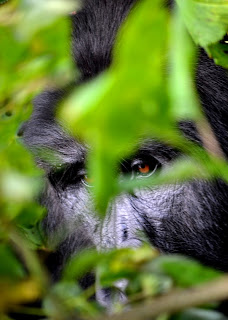Tracking Uganda’s Mountain Gorillas - by Corne Schalkwyk
In a small country about the size of one of South Africa’s
smaller provinces, you will find it all: from forests and fertile soils, animal
life and a wide diversity of tribes, rivers and lakes to lush vegetation thick
with chirping birds, and savannahs where wild beasts prowl. This is Uganda,
where you will feel welcomed by the warm climate and the bright smiles. You
would be forgiven for asking what to tackle first. My first mission in Uganda
was to track down the “hairy people” that inhabit the forests of Bwindi
Impenetrable National Park.
Meeting the “hairy people” of Uganda for the first time is
an exciting and truly memorable experience. Nothing prepares you for the
emotions you experience when you first see a Silverback gorilla in its natural
surroundings. Although there are different subspecies of gorilla, these
mountain gorillas cannot be found in zoos, as they don’t survive in captivity.
Bwindi Impenetrable National Park is located in the
south-western part of Uganda on the rim of the Rift Valley. The mist covered
hillsides are sheltered within one of the oldest and most biologically varied
rainforests in the world. It dates back more than 25,000 years and is home to
approximately 400 different plant species. This “impenetrable” forest also
protects a population of about 400 mountain gorillas – approximately half of
the total remaining mountain gorilla population in the world.
Premier Safaris arranged for me to visit the area in an
attempt to track the historical Mubare gorilla family, one of the first
families that were habituated in Bwindi. After the tragic death of their
leader, the group dwindled in numbers to only five gorillas.
We took the winding – and sometimes terrifying road up the
mountain through breath-taking misty scenery to reach our base camp, aptly
named Silverback Lodge. It was pouring with rain when we arrived and my guide,
Erick, explained that this is normal for the area, as it rains almost daily on
the mountain.
At the lodge, the general manager pointed out the last
location of the group that I was about to track. The next morning we had an
early start from the bottom of the mountain as we retraced the gorillas’ path
from their previous evening’s nests. Erick explained that they make a new nest
every evening at about 19h00. Trackers then use these nests as a starting point
from which to track the group.
 The steep incline of the mountain with its slippery red clay
is not for the unprepared, and I was very grateful that my guide provided me
with a walking stick, even after I had initially indicated that I didn’t think
I would need it. The scenery and incredible diversity of plants and birds en
route, however, more than made up for the long, arduous climb.
The steep incline of the mountain with its slippery red clay
is not for the unprepared, and I was very grateful that my guide provided me
with a walking stick, even after I had initially indicated that I didn’t think
I would need it. The scenery and incredible diversity of plants and birds en
route, however, more than made up for the long, arduous climb.
We finally reached the group a couple of hours and two
mountains later and slowly approached them while being careful to stay out of
sight. My first glimpse was of a Black back gorilla of about eight years old
that suddenly came bursting into view, dragging a female along behind him.
Apparently this is how they steal females from other groups
to add to their own. This must be how the new Silverback – the son of the
previous leader – has managed to grow the Mubare family from its original five
to its current eight members.
With great excitement we observed the family, sometimes a
little closer than was planned, as individual members would suddenly make their
way towards us, observing us with as much curiosity as we did them. They
displayed uncanny human-like characteristics, such as the young member who
threw a tantrum because he had to wait while the Silverback had his fill of a
plant that resembled a water fuchsia.
When it was time to leave the “hairy people” and make our
way down the mountain, I felt a distinct sadness as I glanced over my shoulder
to get the last glimpses of the Silverback as he disciplined a member in the
group.
It is a sight that I will cherish until I can return once
again to this small piece of the “Pearl of Africa”.
For more information on primate safaris or national parks in
Uganda visit www.premiersafaris.com or email
reservations@premiersafaris.com.



Love the article Corne! Most definitely on my bucket list! please continue to share your wonderful travels with us! Take Care, Eugene Relling
ReplyDelete